

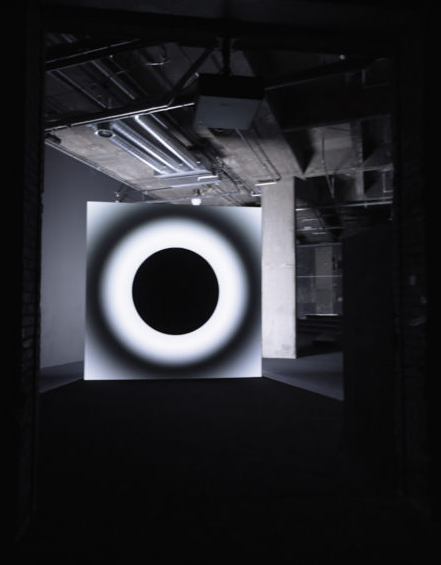
Ryoji Ikeda
point of no return
With point of no return, Ryoji Ikeda condenses the unknowable chaos of the event horizon of a black hole into a work of order and balance. Composing a delicate assemblage of basic shapes, sounds, light and shadow, the artist eschews the intricacies of data for a more sculptural approach. While gesturing towards the sublime, the infinite expanse of space and the immense, reality-warping gravitational force of a black hole, he focuses in on the beauty of the physical, bringing together a few simple elements to make sense of something unthinkably complex. Through his own artistic process of playing with space, the artist finds purity in basic structures while drawing inspiration from the vast scope of the universal. “point of no return is a very simple, very intense piece,” he says.
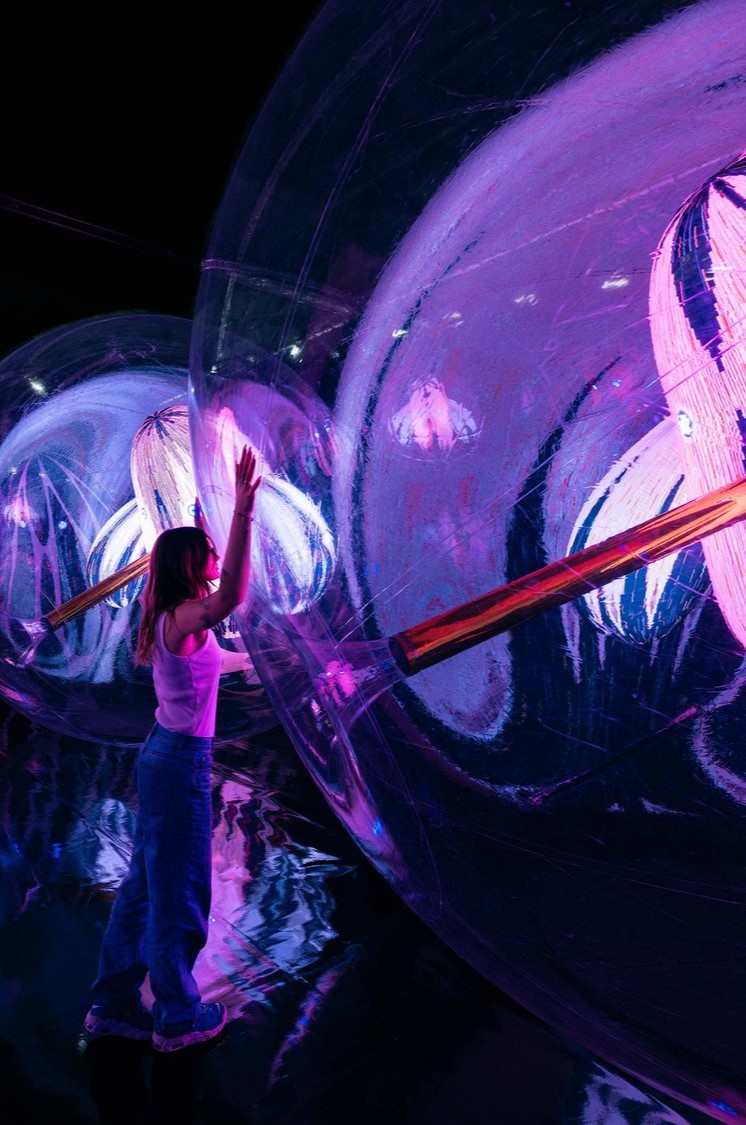
ENESS
Spiritus Sonata
Spiritus Sonata is an artistic representation of animism. ‘Spiritus’ is variously translated from Latin, Hebrew and Greek to mean breath or ‘spirit sense’. With this theoretical combination of breath, spirit, animating the inanimate and investing our characters with digital souls, we aim to engender positive emotion in our audience.
By embedding echoes of childhood play in this installation and linking them to animism we hope to inspire reflection in participants. The same air used to inflate the structures is used to create sounds from their nose extensions, an instrument that operates like an old church pipe organ, another subtle link to worship as well as being a joyful, playful feature.

QUBIT AI: SurrealismToday.com
The Legend of Ogie
FILE 2024 | Aesthetic Synthetics
International Electronic Language Festival
SurrealismToday.com – The Legend of Ogie – United States
What worlds exist beyond Einstein’s speed limit? Inspired by Eric Weinstein’s theory of Geometric Unity, the work explores the idea that space-time is like a melody playing over an eight-dimensional universe. Abstract and metamorphic forms transition from organic forms to parastatic patterns, creating a dance of visuals and sounds that merge into an immersive experience of fractal unfolding.
Bio
SurrealismToday.com is an artist collective and educational platform dedicated to the proliferation of surreal and visionary ontologies in contemporary art. The group began as an esoteric cargo cult dedicated to discovering the beautiful, the fantastic, and the transcendent in the pseudo-philosophical landscape of the art world. His methods include searching for gems in the digital world and infusing mystical enchantments into generative diffusion models.

Alter-Projects and Servaire & Co
Metronome
Alter-Projects and Servaire & Co have partnered to design Metronome, an oscillating installation at the London Design Biennale created to trigger memories through sounds and smells. The installation is a room with a scent-diffusing physical metronome at its centre accompanied by an ASMR soundscape by designer Steve Lastro.
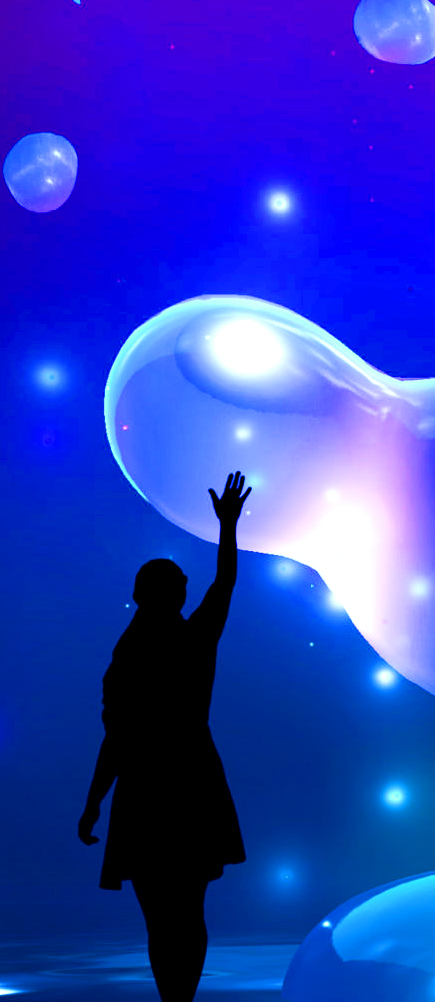
Michaela Pnacekova
A Symphony of Noise
Created by Michaela Pnacekova, Jamie Balliu
Herbert’s everyday sound sources are the inspiration for A Symphony of Noise VR. This interactive virtual reality experience is a journey through four sonic landscapes. The first centers on breathing, which immediately makes you focus on listening to the world differently. This is followed by an arctic environment full of scraping and crunching sounds, and finally a shop interior. Using the controllers or by blowing or singing, you can add sounds to the audio palette, which is visualized as waves and colors in three-dimensional space. In the fourth and final landscape, all the sounds are combined in an ultimate symphony.

Ryoji Ikeda
micro | macro
micro | macro transforms Hall E in the MuseumsQuartier into an oversized world of moving images and sounds. In his immersive installation, multimedia artist Ryoji Ikeda creates a field of imagination between quantum physics, empirical experimentation and human perception. In collaboration with nuclear scientists at CERN, Ikeda has translated complex physical theories into a sensory experience. The Planck scale is used by scientists to denote extremely small lengths or time intervals. Concepts like space and time lose their meaning beyond this scale, and contemporary physics has to rely on speculative theories. And on art. Visitors to micro | macro enter a world of data, particles, light and sound that makes the extremes of the universe perceptible to the eye and ear. In the micro world we penetrate the smallest dimensions of the unrepresentable, while in the macro world we take off into cosmic expanses that allow us to experience the infinite space beyond the observable universe. In this maelstrom of data, an acoustic and visual firework bridges the gap between theoretical understanding and sensual perception.

COD.ACT
Coro pêndulo
Pendulum Choir é uma peça coral original para 9 vozes A Cappella e 18 macacos hidráulicos. O coro é constituindo por um corpo vivo e sonoro. Esse corpo se expressa por meio de vários estados físicos. Sua plasticidade varia de acordo com sua sonoridade. Varia entre sons abstratos, sons repetitivos e sons líricos ou narrativos. Os corpos dos cantores e suas vozes brincam com e contra a gravidade. Eles se tocam e se evitam, criando polifonias vocais sutis. Ou, apoiados por sons eletrônicos, rompem sua coesão e explodem em um voo lírico ou se dobram em um ritual obsessivo e sombrio. O órgão viaja da vida à morte em uma alegoria robótica onde a complexidade tecnológica e o lirismo dos corpos em movimento se combinam em uma obra com acentos prometéicos.
.
Pendulum Choir is an original choral piece for 9 A Cappella voices and 18 hydraulic jacks. The choir is constituted by a living and sonorous body. This body expresses itself through various physical states. Its plasticity varies according to its sound. It varies between abstract sounds, repetitive sounds and lyrical or narrative sounds. The singers’ bodies and their voices play with and against gravity. They touch and avoid each other, creating subtle vocal polyphonies. Or, supported by electronic sounds, they break their cohesion and explode in a lyrical flight or bend in an obsessive and dark ritual. The organ travels from life to death in a robotic allegory where technological complexity and the lyricism of moving bodies combine in a work with Promethean accents.

Juri Hwang
Somatic Echo
“Somatic Echo” is an experimental sound art and research project that utilizes bone conducted sound as a method to investigate human audition and create an unusual and mesmerizing aesthetic of the body as a medium of sound. The installation uses a reclining chair and a sound mask to play an 8-channel sound composition through 8 transducers placed on the user’s head: 6 channels in the face and 2 in the back of the head. The transducers transmit sound through the bone structure of the skull directly to the listener’s inner ear, bypassing the outer ears, which normally are the gateway for auditory signals. The listeners experience the soundscape through both their auditory and tactile senses perceiving a sonic image shaped by the sound traveling through the head structure and through vibrations applied to the skin. This set up lets us experience sound through our body and our body through sound.
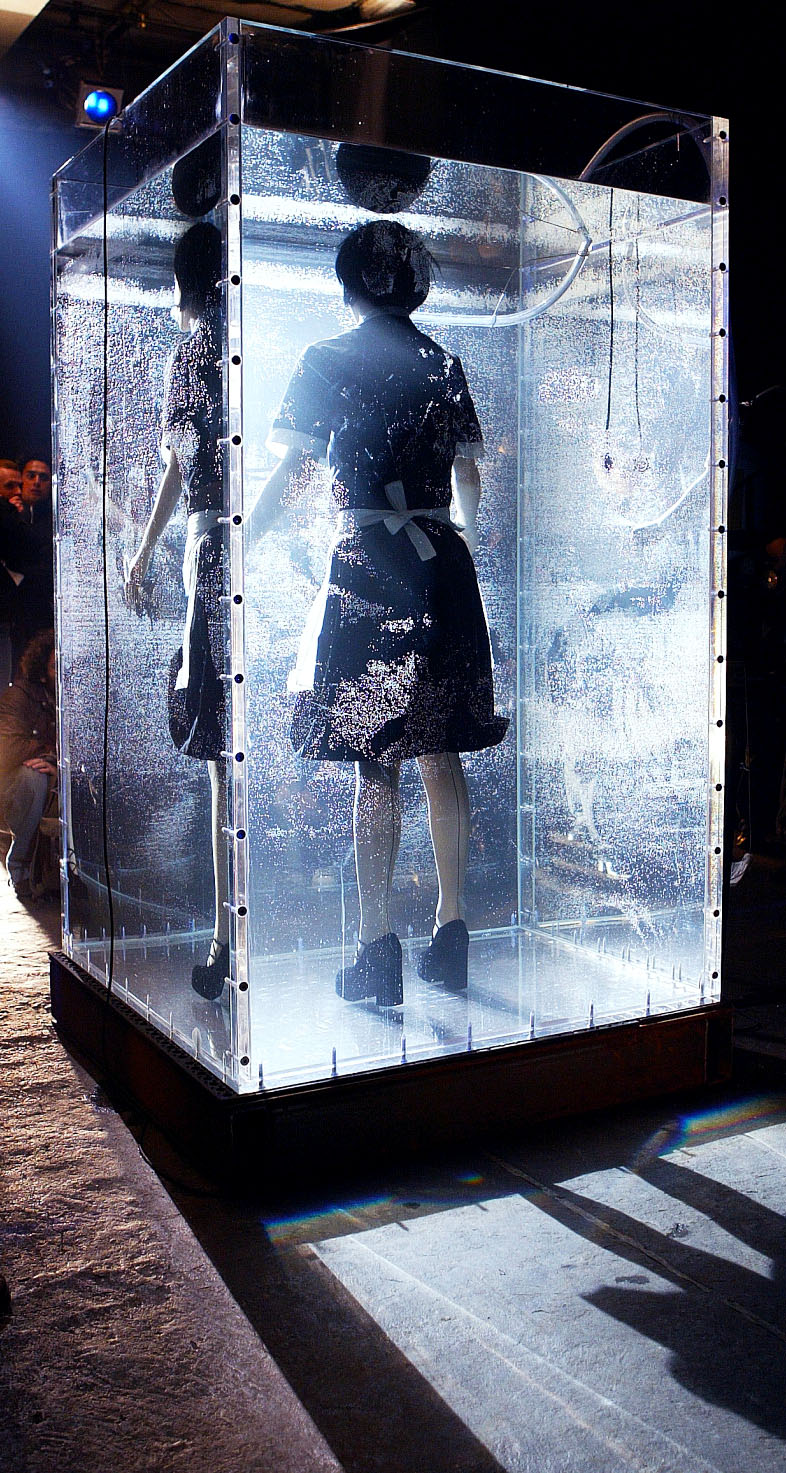
Kris Verdonck
IN
In IN (2003) an actress remains motionless for an hour in a display window filled with water. The distortion to her senses caused by the environment she is in makes her go into a trance. The sounds of her breathing and movement are amplified by microphones.

MASAKI FUJIHATA
beyond pages
The data projector loads images of a leather bound tome onto a tablet which a light pen activates, animating the objects named in it – stone, apple, door, light, writing. The soundscore immaculately emulates the motion of each against paper, save for the syllabic glyphs of Japanese script, for which a voice pronounces the selected syllable. Stone and apple roll and drag across the page, light illuminates a paper-shaded desklamp; door opens a video door in front of where you read, a naked infant romping, lifesize and laughing, in.

TOSHIO IWAI
Piano
Iwai’s Piano — As Image Media (1995), a later sound work, is related to these early interactive experiments. Here the user, seated at the piano, triggers a flow of images that depress the piano’s keys; a consequence of this action releases yet another flight of images. The resulting interactive installation synthesizes two different aesthetics: sounds (simple melodies), images and a mechanical object (the piano) with digital media. A projected score and computer-generated imagery transform the piano into image media, hence the work’s name. Sound is the triumphant component in these works, for it activates and shapes the visual work. But the visual aspect of Iwai’s installations is lovely. His interactive systems appeal to the creative impulses of adults and children alike with their celebration of animation, computer potential, and the joy of sound.07

Alex Ekman
COW
Ekman talents extend to the lighting and stage design and his eye for structuring an environment is unerring. There is no set as such, excepting the plaster cow which dangles overhead, but the stage surface has its share of movement as little island-blocks rise up and pits sink down. The extreme tilting of the stage at one point causes unfortunate Bauch to roll, cow-like, almost into the pit. COW has its iconic Ekman moment in the scene that opens on a stage full of swirling dancers in white skirts set in a magical silvery mist. Mikael Karlsson, whose music partners the piece provides a subtle and evocative soundscape. He offers a hint of percussive rhythm picked up by the dancers who launch into an ecstatic dance: a stage full of whirling dervishes, until they collapse exhausted.
.
Ekmans Talente erstrecken sich auf die Beleuchtung und das Bühnenbild, und sein Auge für die Strukturierung einer Umgebung ist unfehlbar. Es gibt kein Set als solches, außer der Gipskuh, die über ihnen baumelt, aber die Bühnenoberfläche hat ihren Anteil an Bewegung, wenn kleine Inselblöcke aufsteigen und Gruben sinken. Das extreme Kippen der Bühne an einer Stelle führt dazu, dass der unglückliche Bauch kuhartig fast in die Grube rollt. COW hat seinen legendären Ekman-Moment in der Szene, die auf einer Bühne voller wirbelnder Tänzer in weißen Röcken in einem magischen silbernen Nebel beginnt. Mikael Karlsson, dessen Musikpartner das Stück ist, bietet eine subtile und eindrucksvolle Klanglandschaft. Er bietet einen Hauch von perkussivem Rhythmus, der von den Tänzern aufgenommen wurde, die einen ekstatischen Tanz beginnen: eine Bühne voller wirbelnder Derwische, bis sie erschöpft zusammenbrechen.

ALWIN NIKOLAIS
Noumenon
A truly universal artist, the American Alwin Nikolais (1910-1993) devoted his life to a radical form of staged art he called “dance theater.” Inspired (perhaps unconsciously) by the experiments of Bauhaus members such as Oskar Schlemmer and László Moholy-Nagy in the 1920s, Nikolais devised a style of abstract dance that encompassed costumes, stage sets, choreography, lighting, and music, all under his control. Also in 1963, Nikolais met analog synthesizer pioneer Robert Moog, who was at the time just starting his business in New York. He was fascinated by the sounds of Moog’s machines, and with the money provided by a a Guggenheim Fellowship, Nikolais bought the first ever commercially produced Moog synthesizer. It was the primary sound-source for all of Nikolais’ scores from 1963 to 1975. The instrument is now housed at the Stearns Collection of Musical Instruments at the University of Michigan in Ann Arbor.

DI MAINSTONE AND TIM MURRAY-BROWNE
Serendiptichord
The result of a cross-disciplinary investigation spanning fashion, technology, music and dance, the Serendiptichord is a wearable musical instrument that invites the user (or movician) to explore a soundscape through touch and movement. This curious device is housed in a bespoke box and viewed as part of a performance. Unpacked and explored on and around the body, the Serendiptichord only reveals its full potential through the intrepid curiosity of its wearer. Adhering to the body like an extended limb, this instrument is best described as choreophonic prosthetic. Referencing the architectural silhouette of a musical instrument and the soft fabrication of fashion and upholstery, it is designed to entice the movician to explore its surface through touch, physical manipulation and expressive movement. Although this acoustic device can be mastered alone, it also holds subtle openings for group interaction.
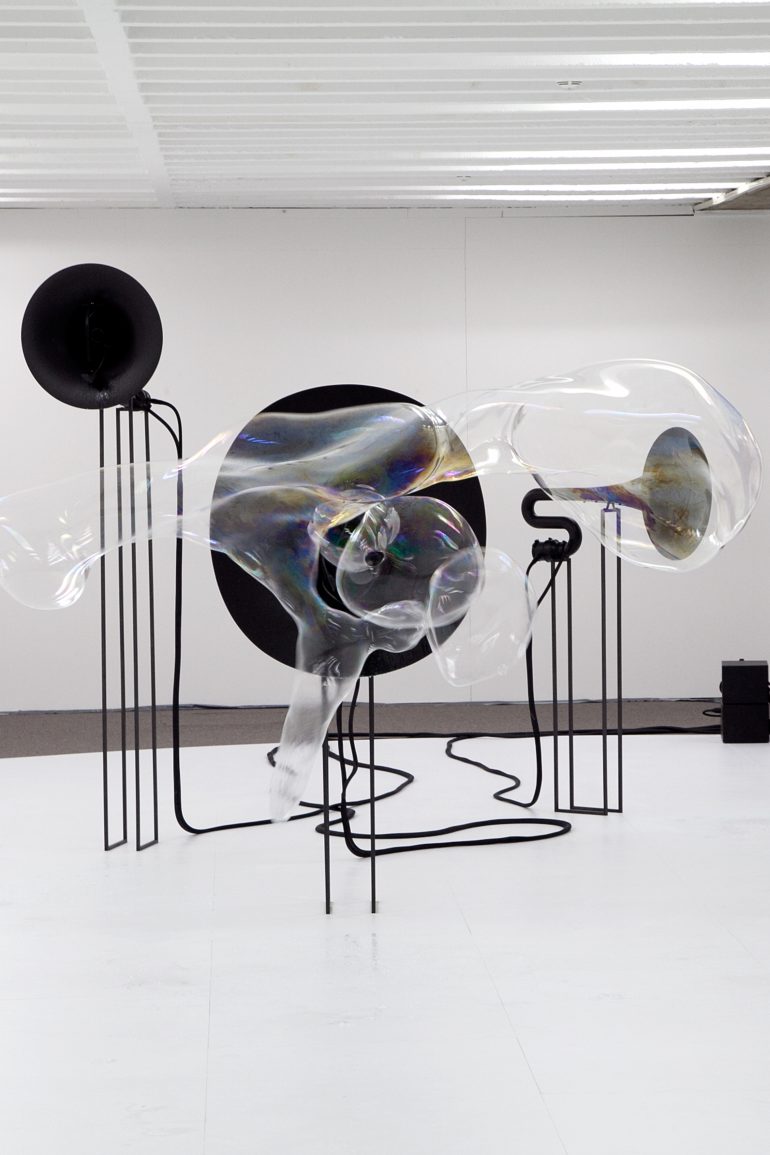
THOM KUBLI
FILE SAO PAULO 2017
BLACK HOLE HORIZON
The nucleus of the installation is the invention of an apparatus resembling a ship horn. With the sounding of each tone, a huge soap bubble emerges from the horn. It grows while the tone sounds, peels off the horn, lingers through the exhibition space and finally bursts at an erratic position within the room.

Stelarc
StickMan
StickMan is a minimal but full-body exoskeleton that algorithmically actuates the artist with 6 degrees-of-freedom. It is a gesture generating system capable of 64 possible combinations. Sensors on StickMan generate sounds that augment the pneumatic noise and register the limb movements. A ring of 6 speakers directs and circulates the sounds.
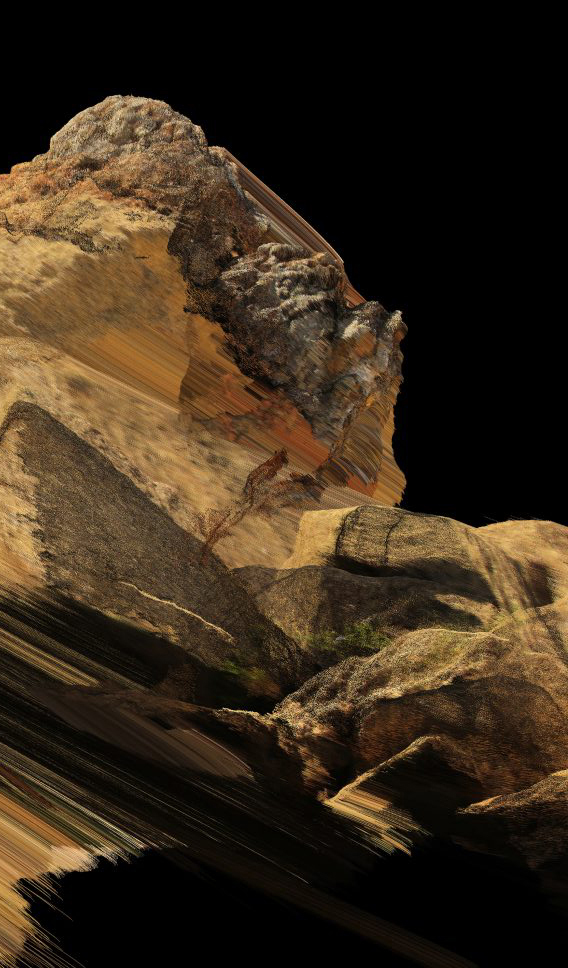
François Quévillon
Unearth
Rotsen van de aardmantel komen uit de leegte tevoorschijn, gefragmenteerd in een veelvoud aan gezichtspunten. Met een hypnotiserende en schurende soundscape bewegen ze zich op een schilderkunstige manier om het publiek heen. Hun gelaagde zanderige pixelsporen worden langzaam weggespoeld. Unearth is gemaakt voor de .dreams-tentoonstelling van Generative Gallery in het Theatre of Digital Art in Dubai. Het meeslepende stuk weerspiegelt de kustsituatie van de stad naast de woestijn en de voortdurend veranderende omgeving, sterk hervormd door mensen, kwetsbaar voor natuurlijke fenomenen, klimaatverandering en de vraag naar hulpbronnen.

Nicolas Bernier
frequencies (light quanta)
The project is part of an ongoing process entitled «frequencies», exploring basic sound and light dichotomic systems. Here, frequencies (light quanta) stems from a fascination towards science, light, and granular synthesis allowing to create clouds/grains of sounds. The conceptual focus lies in the quantum — the smallest measurable value of energy —, on the smallness of matter. The whole project is based on the possible conceptual relationships between basic quantum physics principles applied to the audio-visual creative process: particles, probabilities, wave/particle duality and discontinuity. Metaphorically structured around these notions, the audio-visual composition stems from 100 sound and light micro-sequences that develop themselves, generating an ever expending but yet disruptive form in time and space. With the use of randomness, the vectorial graphics are always creating new ways to look at the visual, physically superimposing pattern images.

Laura Splan
Disrupted Domains
Disrupted Domains features new animations created with molecular visualization software and SARS-CoV-2 structures displayed in Quorum at the Science Center. The animations were developed in remote collaboration with uCity Square biotech company Integral Molecular for Splan’s Science Center Bioart Residency while “sheltering in place” for COVID-19. The work in the exhibition is part of Precarious Structures, Splan’s project that explores the interconnectedness of cultural and biological systems during the coronavirus pandemic. Accompanying soundscape by Frank Masciocchi recorded in collaboration with Splan over Zoom.
VIDEO
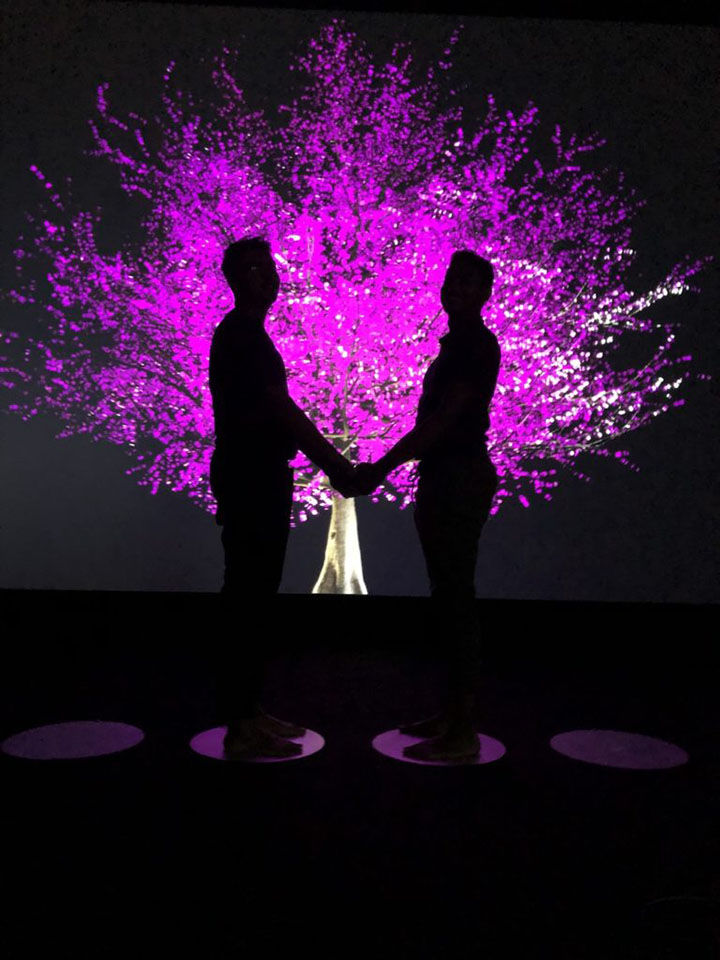
Lisa Park
Blooming
“Blooming” is an interactive audiovisual installation that highlights the importance of human connection. It takes the form of a life-size 3D Cherry blossom tree, which is a common symbol of social ties and transience of life in East Asian culture. As a response to participants’ skin-to-skin contacts, heart rate, and gestures, “Blooming” blossoms according to their intimacy. As audience members hold hands or embrace, the digital Cherry tree flowers bloom and scatter. When they let go off their physical contacts, the flower return to its pre-bloom state. The color of the flowers turns white or red based on participants’ heart rate as they interact with each other. (the faster the heart rate, the redder the tonality; the slower the heart rate, the whiter the tonality). In addition to the visual responses, sounds are also modulated according to the tree’s different stages: pre-bloom, blooming, petals falling.

Sean Kerr and Judy Darragh
In Kahoots
“In Kahoots is an ever-changing 3D experience that in a sense feeds on itself – by reworking the artists’ source material, the algorithm constantly regenerates its own sounds and images into new art. This is the first time In Kahoots has been to Christchurch – but really, everyone who visits will experience a first. In Kahoots encourages people to literally be a part of a truly unique work of art, and create lifelong memories for audiences of all ages. It’s fun for kids, and food for thought for everyone looking for a little extra.” Nathan Pōhio

Peter Eötvö
Peter Eötvös
Multiversum
Multiversum is written for two solo instruments and orchestra, for two instruments of the same family: the traditional organ with its rich but static colours and the modern Hammond, which can continuously change colours. It was very important for me that the sound of the two organs could completely wrap around the audience, like we imagine the cosmos envelops us. The traditional organ sounds from the front, the Hammond from the back. If we visualise the two organs as our galaxy, then the different groups of the orchestra can represent different galaxies. That’s how the “Universe” becomes the “Multiversum”.

Doug Aitken
Sonic Mountain
As a unique site-specific commission for the Donum Estate, Los Angeles-based artist Doug Aitken has created the ethereal work Sonic Mountain (Sonoma), three concentric circles of suspended stainless-steel pipes whose differing lengths form a wave at their base, mirroring the free Euler-Bernoulli shape that describes the chime’s frequency. Installed in the eucalyptus grove, measuring forty-five feet in diameter and twice human height, and comprising 365 chimes — one for each day of the year — Sonic Mountain (Sonoma) works with one of Donum’s most persistent elements, the Carneros breeze that cools the grapes and creates a temperate zone for growing Pinot Noir. Each day, the warm wind begins its soft whisper, rustling through the vines and trees, building in strength through the day until mid-afternoon, and then gradually diminishing in force. Known to have been used since at least the ancient Roman period in Europe and the second century in India and China, wind chimes create chance, inharmonic music. At Donum, Aitken has teamed up with his friend the composer Terry Riley to compose chords in the chimes to be played by the wind , depending on how it blows, so the lyrical work sounds throughout the estate, demonstrating the artist’s practice of making installations that synthesize many media and are never constrained by tradition.
video

Judith Barry
Imagination Dead Imagine
An androgynous head is projected as if contained within a minimalist cube. Sounds of the head slowly breathing fill the space. The head is serene, waiting. Suddenly a substance pours over it from all sides, drenching it in what appears to be a bodily fluid. The spectator wants to turn away but can not, the gaze is compelled through the invocation of the scopic drive. Horror at the repulsive nature of the substance (the abject) is replaced by fascination with the beauty of what might be considered a contemporary sublime.
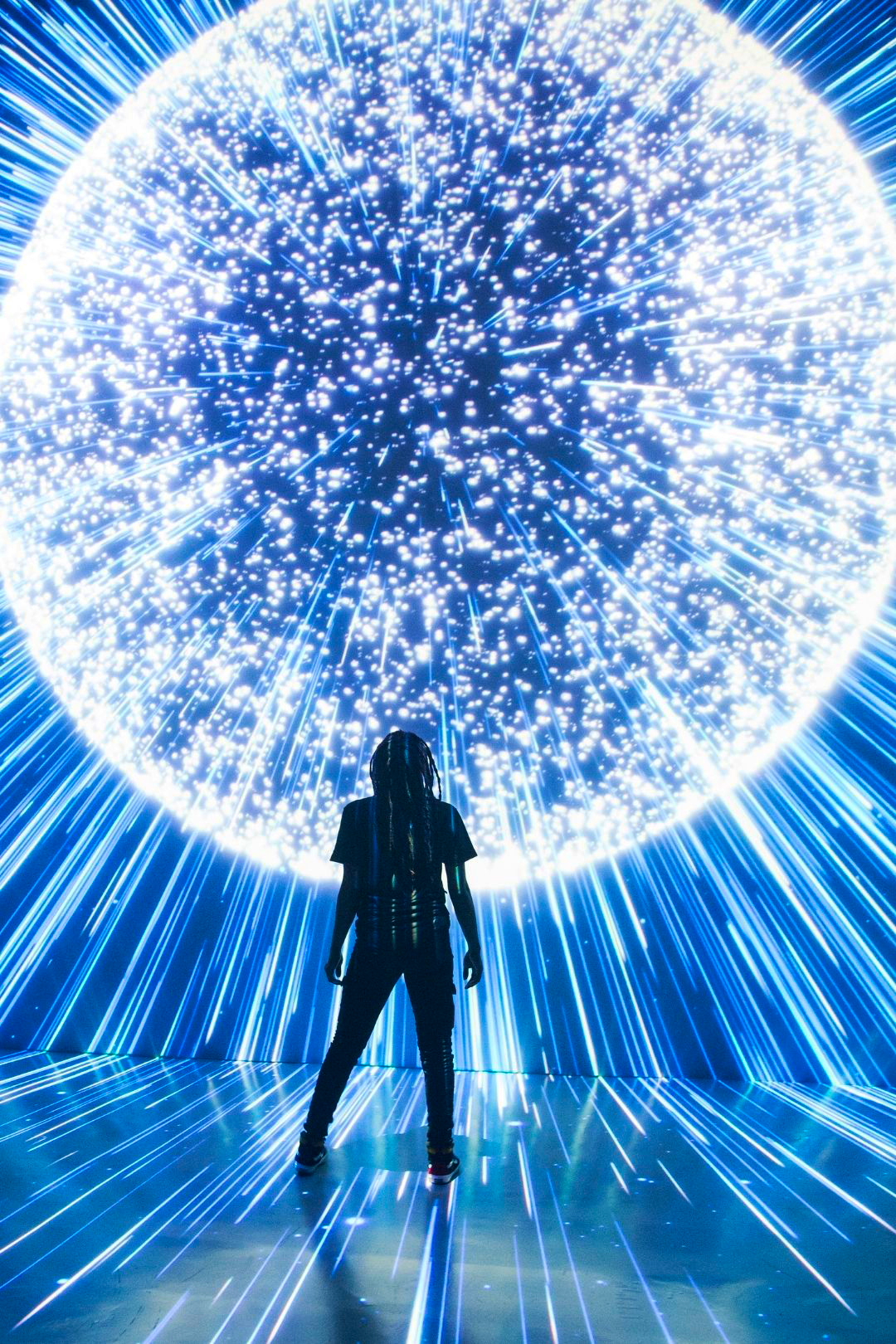
ARTECHOUSE NYC
Celestial
Drawing on Pantone Color of the Year 2020 Classic Blue’s inspirational qualities, “Celestial” takes visitors on a journey beyond the skies. This technology-powered, multi-sensory installation transcends space and time— pushing the limits of our imagination and opening up a new realm of possibilities. Submerge yourself in the sights, sounds and sensations of Classic Blue.

UVA United Visual Artists
Great Animal Orchestra
The Fondation Cartier invited United Visual Artists to collaborate on The Great Animal Orchestra, exhibition that celebrates the work of musician, bio-acoustician and scientist Bernie Krause. Krause has been recording animals for 45 years and has amassed a collection of more than 5,000 hours of sounds recording of over 15,000 individual species in their natural habitats from all over the world. UVA’s creative approach linked together the various exhibition content elements throughout the basement space — soundscapes, spectrograms and art works — into a cohesive, immersive experience that three-dimensionalises Krause’s recordings and suggests scenes from the natural world. The spectrograms form an abstract landscape, an interpretation of the various global locations and times of day that Krause made the original recordings in a way that envelops the audience and encourages them to linger in the space.

Riccardo Torresi, Maxime Lethelier, Asako Fujimoto
Satellarium II
Sun Outage is a degradation or temporary interruption of satellite signal caused by solar radiation. In these moments satellites occur to be in between the Sun and the Earth, producing with their shadows an invisible eclipse. Satellarium II shows these astronomical events through a variation of visuals and sounds in the room in which it is exhibited. The installation consists of a set up of multi channel surround speakers and graphics projected on a disk above the viewers, representing the fragment of the visible sky from the location of the artwork. Visuals and sounds are based on real time tracking of the satellites position and magnitude (brightness of a satellite as it appears in the night sky from Earth). The gradient on the background of the projection represents the sun and it is related to its real-time position in the sky.

MYMK Bruno Sres
Garlands
Into Promenade
…But the best thing about MYMK is his music needs no adornment; the bonuses are simply icing on the cake…We’ve referred to MYMK as drone, electronic and experimental... spreading his sounds like Sodeoka’s spilled paint. Garlands are decorations we associate with victories; Garlands is one of them. (Richard Allen)
visual designer and artist: Yoshi Sodeoka
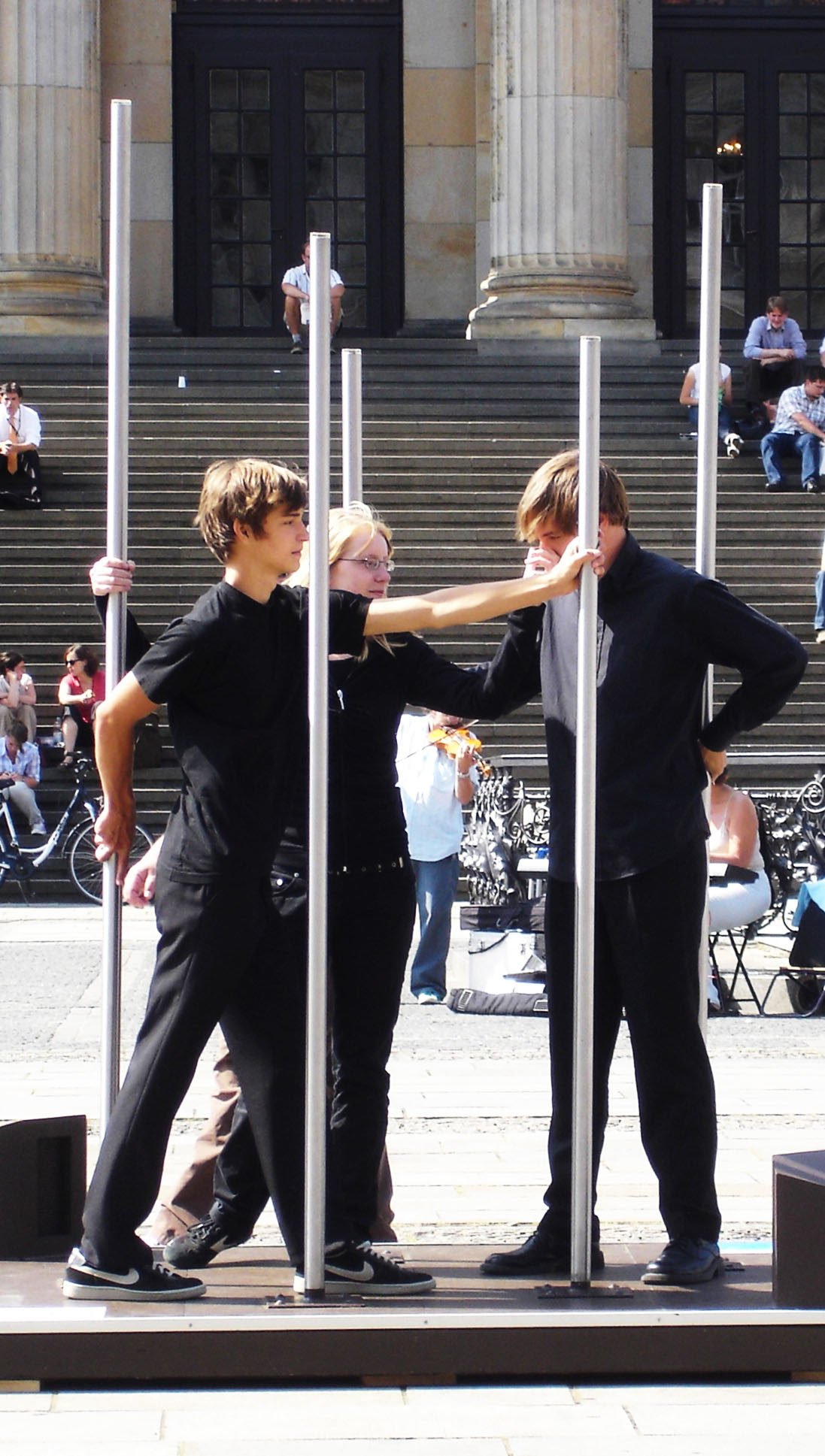
Erwin Stache
Kilo Ohm
Erwin Stache is a German composer and sound artist who designs installations for specific locations. His Kilo Ohm – which you can of course try out yourself – uses the electrical resistance of the player’s skin to generate sound. Each new touch sounds different.

BILL VIOLA
The Raft
The Raft depicts at life-sized scale a group of ordinary people casually standing together. Suddenly, they are struck by strong blasts of water that rush in, overtake them, and then, just as unexpectedly, recede. In the aftermath of the deluge, the victims huddle together, seek protection, and help those who have fallen. The viewer experiences this event in an immersive setting, standing in a darkened room and surrounded by the roaring sounds of the water. Meticulously captured in slow-motion, The Raft arouses a visceral experience of human calamity and shared humanity, provoking a consideration of the range of responses to crisis.
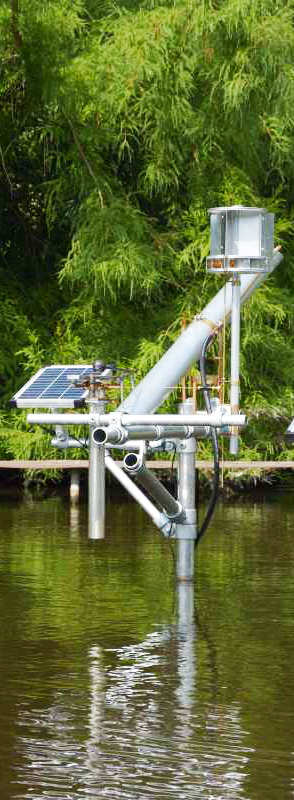
Ronald van der Meijs
Odoshi Cloud Sequence
A symbiosis between nature and culture is created against the backdrop of the Japanese garden in the pond of the Amstelpark. This artwork explores new possibilities to generate sound and composition that are controlled by slow, unpredictable and unexpected elements of nature which are highly respected in Japanese culture. The diversity of natural sounds gives the work an almost meditative character, while the dependance on natural factors evoke a tension between longing and acceptance. This sound installation engages, as a natural sequencer, in a dialogue with the water, sun wind and clouds. It refers to Japanese garden culture by using the principle of the Japanese bamboo water tumbler.

Olivier Ratsi
Frame Perspective
Measuring 30m x 30m x 2.4m and featuring LED lights and 8 audio channels, Frame Perspective transforms a cavernous space at the Maison de la Région. On specific dates throughout the Constellations festival Ratsi has prepared a light programme in the space, accompanied by a sound composition played by Thomas Vaquié (see the festival programme for more details). Frame Perspective continues Ratsi’s interrogation of reality through the creation of exploratory and peripheral spaces. The installation’s repeating forms create new dimensions in the Maison de la Région, interrupting the lines of the architecture. Meanwhile the composition of interacting lights and sounds disrupts the sonic and visual textures of the space and resonates with the visitor on uncharted frequencies. The effect is to immerse the visitor into a fluctuating environment which connects digital technologies with physical spaces and raises questions about how reality is constructed and experienced in digital, physical and other realms.
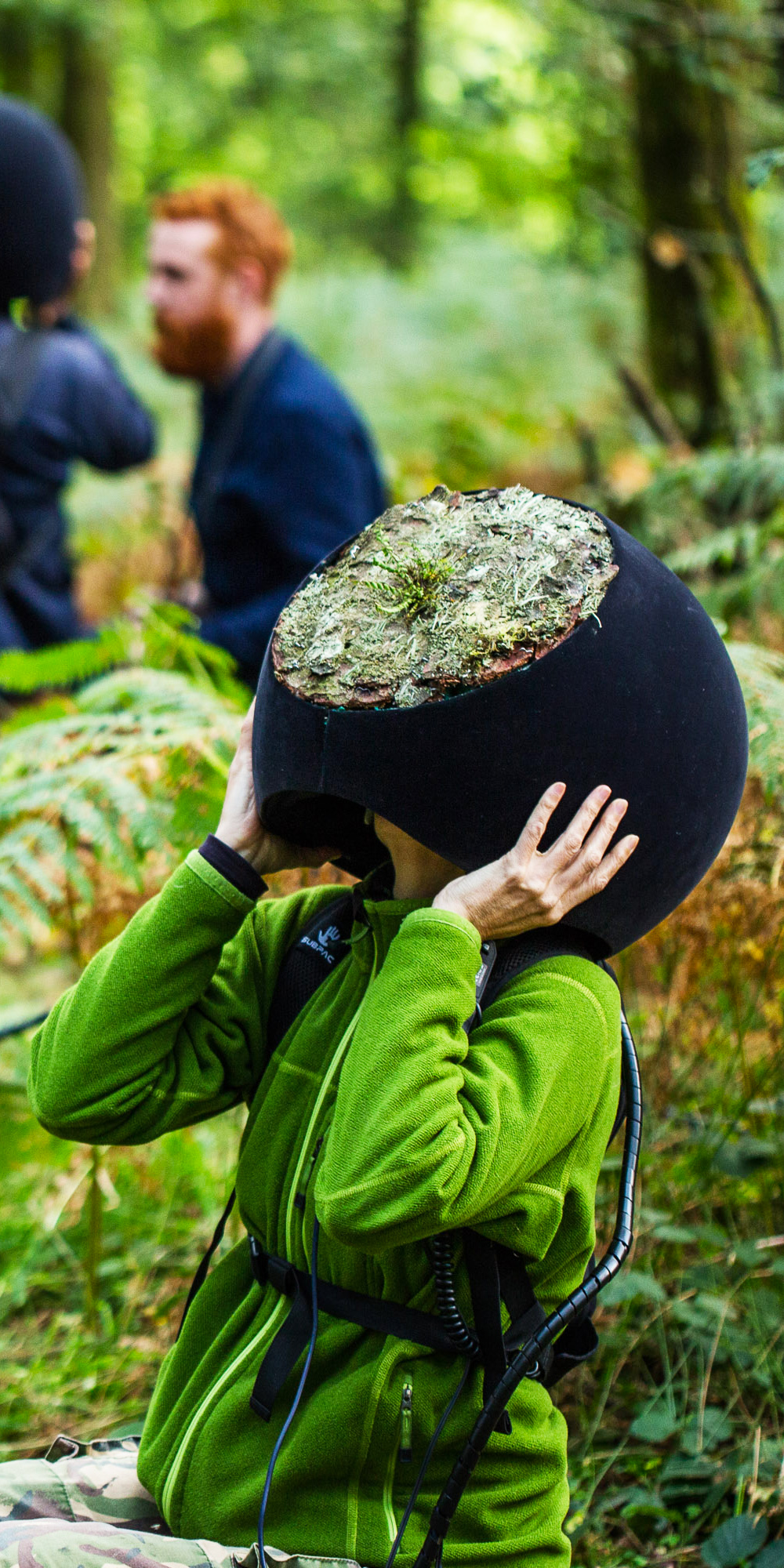
Marshmallow Laser Feast
In the Eyes of the Animal
In the Eyes of the Animal, a journey through the food chain, is an artistic interpretation of the sensory perspectives of three British species. Created using Lidar scans, unmanned aerial vehicles (UAVs) or drones & bespoke 360° cameras, the piece is set to a binaural soundscape using audio recordings sourced from Grizedale Forest in the north of England.

João Martinho Moura
WIDE/SIDE
WIDE/SIDE is an interactive installation in which shapes, images, and sounds are joined and interdependent. A visually engaging block, captivating in its monochromatic conception and minimalist lines, serves as a projection screen and teems with conglomerations of lines and shapes. As a result the installation is always changing and acquiring countless different forms.
The individual forms of the projections in reality are based on the surrounding environment, responding to the movements and gestures of the viewers. Visitors and passersby therefore themselves become part of the work and define its appearance.
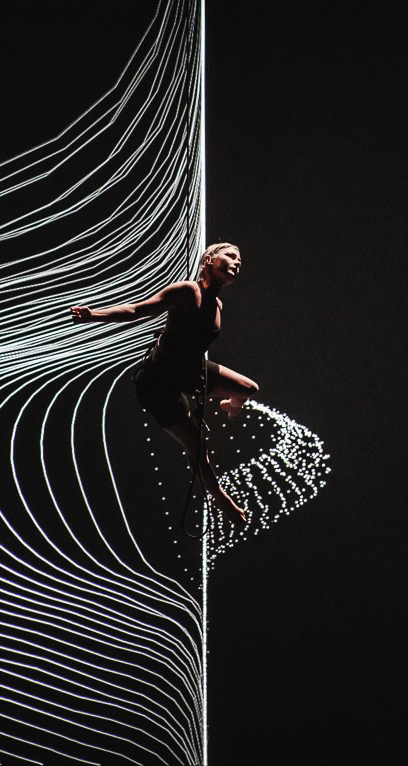
Fuse
Ljós
Ljós (Icelandic for ‘light’) has been conceived in continuity with the research carried out by fuse* in the field of digital and performative arts, which explores the deep connection between light, space, sound and movement. In Ljós, the performer is the means that allows the viewer to access a surreal and dreamlike space, a dimension with no gravity nor time, made by sounds and images reacting and interacting in real time. A shape-changing universe, which evolves from amniotic fluid in the beginning – protecting and supporting the performer – to the setting for violent explosions and transformations later – leading her to a direct contact with ground and Earth.

Sally Golding
Your double my double our ghost
The installation acts a space for the consideration of intimacy and meditation– both alone and with others that may share the space – through the merging of the viewer’s own reflections articulated through a composition of shifting light and emerging sounds which fill an otherwise dark chamber. Functioning similarly to the classic funfair mirror– the flexible silver two-way mirror sheeting forming an ethereal hanging centrepiece– the work invites the viewer to consider representations of themselves which appear distorted and transient, and which merge with those around them to form ‘new presences’. In this sense the viewer may see themselves multiplied or doubled with another viewer, or find themselves alone in a rare moment of literal reflection providing a contemplative space or eliciting a hallucinatory fantasy bringing forth ideas in neuroscience around the Self and Other.

Andy Thomas
Audio life forms
Australian artist Andy Thomas specializes in creating ‘audio life forms’: beautiful abstract shapes that react to sounds. In this animated short, he visualizes two recorded bird sounds from the archives of the Netherlands Institute for Sound and Vision in Hilversum.
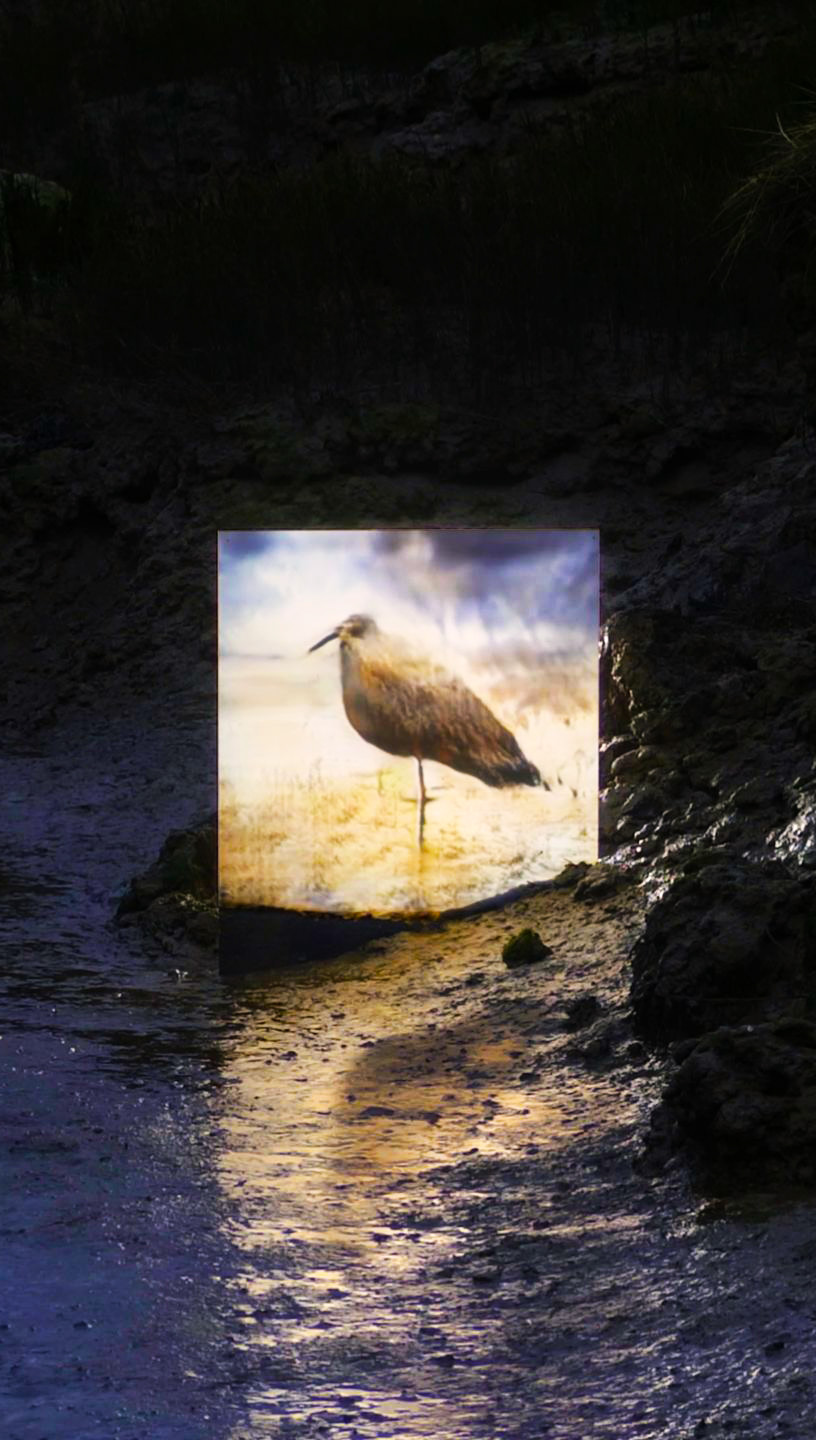
Jake Elwes
Cusp
A familiar childhood location on the Essex marshes is reframed by inserting images randomly generated by a neural network (GAN*) into this tidal landscape. Initially trained on a photographic dataset, the machine proceeds to learn the embedded qualities of different marsh birds, in the process revealing forms that fluctuate between species, with unanticipated variations emerging without reference to human systems of classification. Birds have been actively selected from among the images conceived by the neural network, and then combined into a single animation that migrates from bird to bird, accompanied by a soundscape of artificially generated bird song. The final work records these generated forms as they are projected, using a portable perspex screen, across the mudflats in Landermere Creek.

Jascha Dormann
Sounds of Silence
Inside the exhibition, there’s not a word of written text, and few traditional photos or videos. Instead, you get abstract spatial graphics. Tracking systems respond as you navigate the exhibit, and an unseen voice hints at what you might do. There’s a snowy cotton-like entry, radio-like sound effects, and then a pathway to explore silence from the start of the universe until this century.

Iwai Toshio and Nishibori Ty
Tenori-On
Media artist Toshio Iwai and and Yu Nishibori of the Music and Human Interface Group, Yamaha Center for Advanced Sound Technology, have collaborated to design a new digital musical instrument for the 21st+century, TENORI-ON. A 16×16 matrix of LED switches allows everyone to play music intuitively, creating a “visible music” interface. It consists of a hand-held screen with a grid of LED switches, any of which can be activated in a number of ways to create an evolving musical soundscape. The LED switches are held within a magnesium frame, which has two built-in speakers located on the top of frame, as well as a dial and buttons that control the type of sound and beats per minute produced.
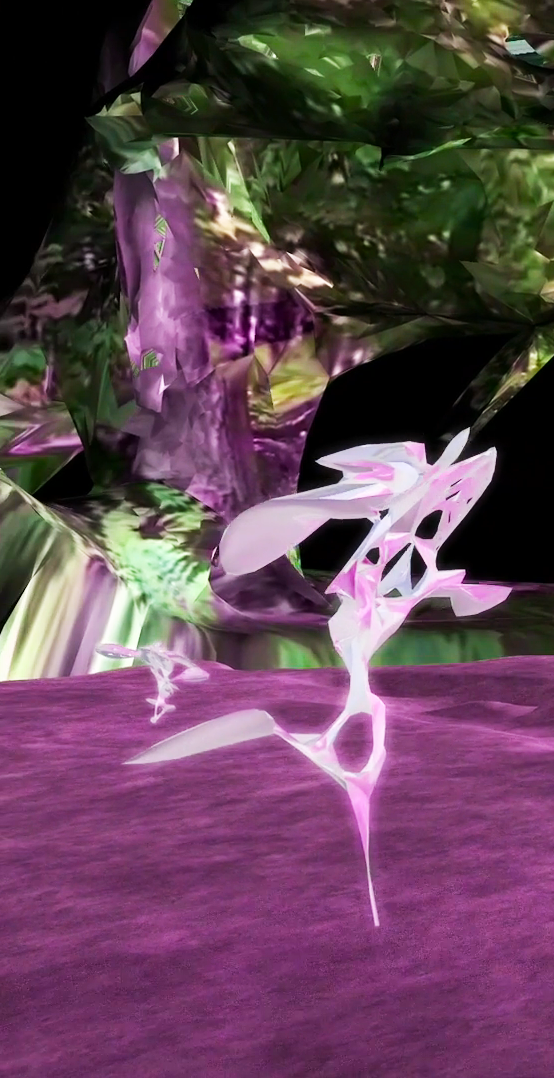
Isabella Münnich
Immersed Garden
Immersed Garden is in its true sense a sunken world. Floating bodiless in an underwater garden, natural sounds guide you through an immersive surrounding, somewhere between calming and irritating, natural and artificial. It is a playful exploration of the individual conception of safety and confusion and a personal approach to aesthetic references to habits of introspection and retreat in digital environments. It was created by fusing different digital processes like photogrammetry of selected natural places around Karlsruhe and field recordings in a local natural reserve. Underwater videos hybridize with 3D scans of trees and plants while invisible frogs are croaking and humming birds are buzzing by synthetic flowers. The artistic aim was to explore the personal perception of calming and irritating, playing with the concept of immaterialness and attentiveness. The artwork creates aesthetic references to philosophical and scientific theories of introspection and identity.
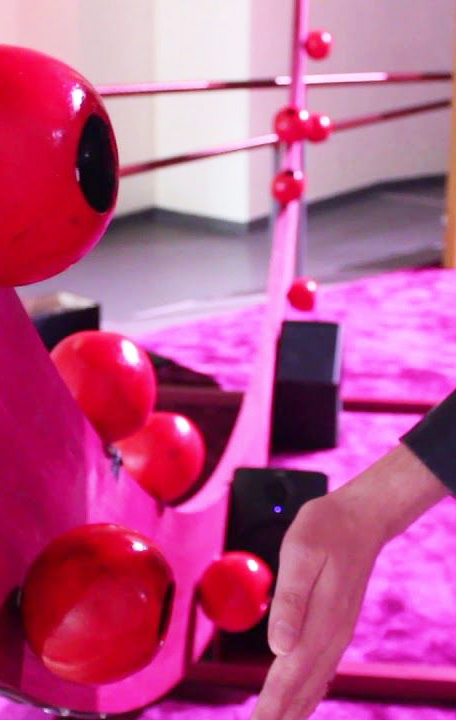
Anders Lind and Ulla Karlsson
Skogen/The forest
Skogen/The forest is an interactive sound art exhibition created by Swedish composer Anders Lind in collaboration with Swedish scenographer Ulla Karlsson. THE FOREST is created as a multiplayer orchestra platform for novices (or experts). Within THE FOREST the visitors becomes orchestra performers ready to explore preprocessed sounds from the Swedish forest in combination with sounds from a traditional symphony orchestra. THE FOREST was first exhibited at Norrlandsoperan, Umeå, Sweden in 2019.

Wolfgang Buttress
The Hive Kew Gardens
“The proposal involves the idea of ’temporary’ in an interesting way. It uses the temporary aspect of the installation to carefully engage with the purpose and short and long-term needs of the land,” said the judges. Originally designed for the Expo 2015 from Milan, The Hive was transferred to Kew Gardens, in central London, for two years, where it was part of an event space. Designed to give visitors a glimpse into the life of working bees, the pavilion was built with 169,300 individual aluminum components equipped with hundreds of LED lights. As the meadow surrounding the structure grows, several species of plants begin to flourish, bringing with them the sounds of real bees that enhance the multi-sensory experience of the pavilion.The aesthetic and symbolic installation represents its namesake, with the aim of showing visitors the importance of protecting the honeybee.
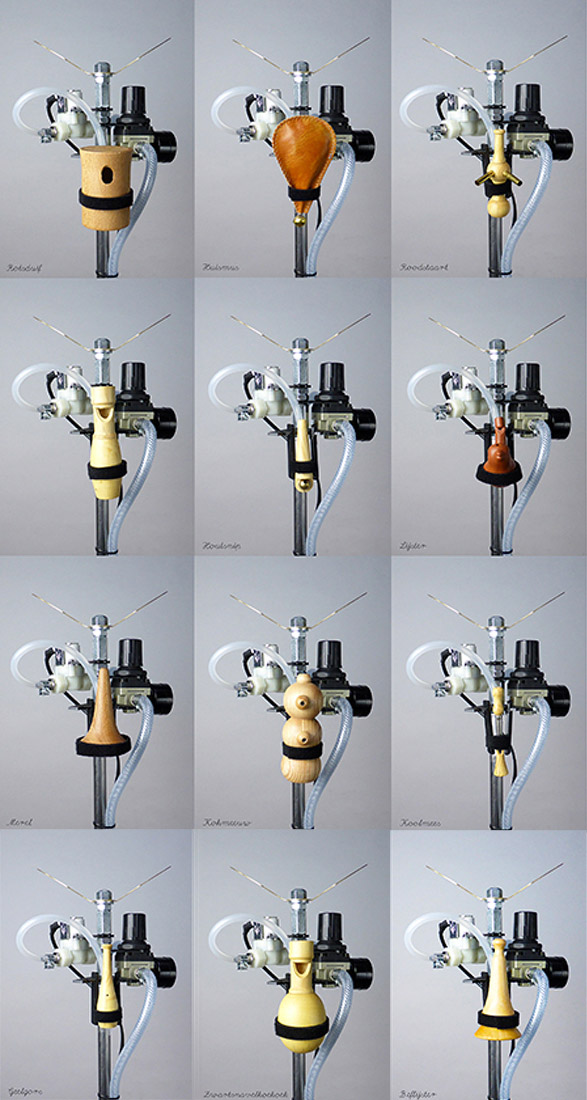
Jelle Mastenbroek
The Robin Who Wondered If He Was a Nightingale
Various members of orchestra perform impressive improvisations based on your identity and the natural environment. The flutes combine their sounds with the rhythm of the percussion. The special acoustics of the forest played an important role. Every time an attempt is made to deliver the highest quality of improvisation and to achieve more than perfectly played notes. This creates a magical and unforgettable experience. Musicians: Nightingale, Cuckoo, Moorhen, Pigeon, Curlew, Black-billed Cuckoo, House Sparrow, Little Owl, Woodcock, Green Woodpecker, Great Spotted Woodpecker, Middle Spotted Woodpecker, Lesser Spotted Woodpecker.

REVITAL COHEN & TUUR VAN BALEN
The Immortal
A number of life-support machines are connected to each other, circulating liquids and air in attempt to mimic a biological structure.
The Immortal investigates human dependence on electronics, the desire to make machines replicate organisms and our perception of anatomy as reflected by biomedical engineering.
A web of tubes and electric cords are interwoven in closed circuits through a Heart-Lung Machine, Dialysis Machine, an Infant Incubator, a Mechanical Ventilator and an Intraoperative Cell Salvage Machine. The organ replacement machines operate in orchestrated loops, keeping each other alive through circulation of electrical impulses, oxygen and artificial blood.
Salted water acts as blood replacement: throughout the artificial circulatory system minerals are added and filtered out again, the blood gets oxygenated via contact with the oxygen cycle, and an ECG device monitors the system’s heartbeat. As the fluid pumps around the room in a meditative pulse, the sound of mechanical breath and slow humming of motors resonates in the body through a comforting yet disquieting soundscape.Life support machines are extraordinary devices; computers designed to activate our bodies when anatomy fails, hidden away in hospital wards. Although they are designed as the ultimate utilitarian appliances, they are extremely meaningful and carry a complex social, cultural and ethical subtext. While life prolonging technologies are invented as emergency measures to combat or delay death, my interest lies in considering these devices as a human enhancement strategy.This work is a continuation of my investigation of the patient as a cyborg, questioning the relationship between medicine and techno- fantasies about mechanical bodies, hyper abilities and posthumanism.
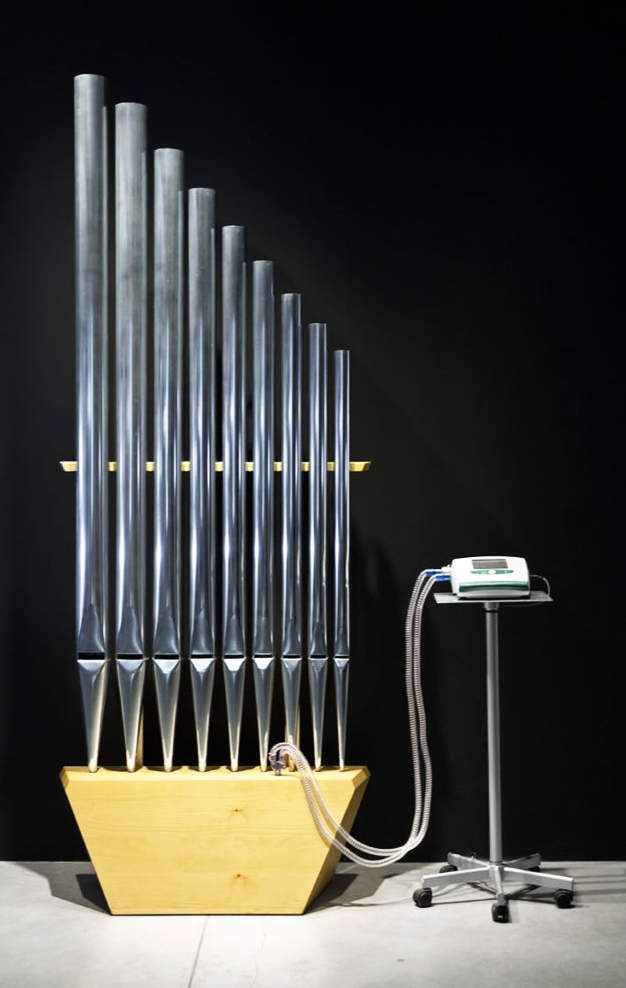
Michele Spanghero
Ad lib
The sound sculpture Ad lib. combines a medical machine for automatic pulmonary ventilation with a few organ pipes that play a musical chord to the constant rhythm of the mechanical breath, creating an artificial organ that is metaphorically a mechanical requiem that sounds incessantly. The title of the work Ad lib., an abbreviation of the Latin expression “ad libitum”, is a musical caption that gives the performer discretion of interpretation, allowing for instance to repeat “at will” certain bars of the score. The sculpture aims to refer to the situation in which people, who suffer from critical health conditions, see their survival tied to a breathing machine and, therefore, to the discretion of those who are taking care of them.

Harrison Pearce
Defence Cascade
In the installation inflated silicone forms are suspended amidst an austere metal structure, and are prodded by automated rods. Set to contrastingly beautiful music by composer Alex Mills, which is punctuated by the industrial sounds of the mechanised device, the art work looks like a science experiment, or some kind of torture device, and you may find yourself anthropomorphising the poor, inflated bags which are at the mercy of their mechanical environment.

Marnix de Nijs
Lost Dimension
Lost Dimension Non-dimensional Cities is an immersive cinematic experience in which participants journey through an endlessly unfolding virtual cityscape that expands over all axes. This dimensionless cityscape is constructed from a large collection of point clouds and sounds. While the user is standing on the controller pod and navigates through this virtual world, a sense of physical instability takes over and the platform becomes an anchor to hold on to. The building blocks of the world are generated from depth map information and panoramic photographs obtained from Google Street View’s API. Depending on the user’s position in the virtual world these blocks are dynamically repositioned on a three-dimensional grid. By subtle manipulation of motion and sound, perspective distortion and shifts in balance Lost Dimension unquestionably re-calibrates the viewer’s perception of dimensionality.

GYÖRGY LIGETI
ג’רג’ ליגטי
Дьердь Лигети
ジェルジ·リゲティ
Le Grand Macabre
In the mid-70s, Ligeti wrote his only opera, Le Grand Macabre, loosely based on the 1934 play, La Balade du grand macabre, by Michel De Ghelderode. It is a work of absurd theatre that contains many eschatological references.After having seen Mauricio Kagel’s anti-operatic work Staatstheater, Ligeti came to the conclusion that it was not possible to write any more anti-operas.[citation needed] He therefore resolved to write an “anti-anti-opera”, an opera with an ironic recognition of both operatic traditions and anti-operatic criticism of the genre. From its brief overture, a mixture of rhythmic sounds scored for a dozen car horns, to the closing passacaglia in mock classical style, the work evolves as collage of sonorities ranging from a grouping of urban sounds to snippets of manipulated Beethoven, Rossini and Verdi.

